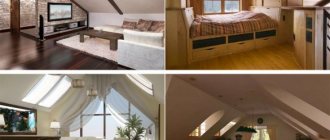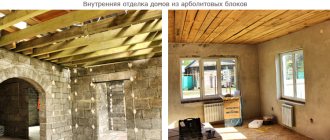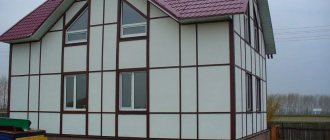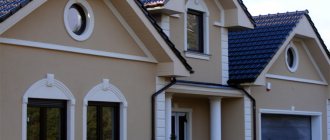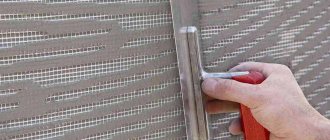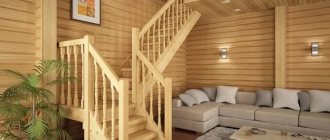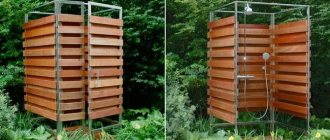Features of production and advantages of MDF
MDF panels are a material consisting of a finely dispersed fraction of wood shavings.
To obtain panels, wood waste is crushed, the resulting fraction undergoes heat treatment, and as a result, an adhesive composition is released - paraffin or lignin. It glues the mass together, and by pressing it gives the necessary strength. Then a melamine film or veneer is glued onto the surface, which gives a beautiful decorative look. Film lamination gives the material an almost indistinguishable resemblance to natural material, while the price remains affordable. The film has different colors and textures, which justifies the widespread use of MDF panels for interior finishing work.
The manufacturing process for MDF is similar to that of particle board. But chipboard contains formaldehyde resins, which are harmful to human health.
In terms of ease of use in the construction industry, chipboard is inferior in reliability of fastening with screws. After some time of use, the holes may become loose and fasteners may fall out. Repairing chips is difficult and sometimes impossible.
MDF boards have a denser structure, which allows them to securely hold fasteners. It is also worth noting the environmental friendliness of MDF. A high-quality board contains only natural substances that are safe to use: wood and carbide resins.
Additional advantages of MDF:
- durability and ability to resist mold and rotting processes;
- water resistance, so the material can be used in rooms with high humidity;
- flexibility when heated, allowing the panel to be slightly curved if necessary.
- maintainability: damaged elements can be easily replaced with new ones without dismantling the entire cladding;
- ease of installation: even beginners in finishing can cope with attaching MDF to a suitable base;
- panels allow you to hide electrical and other communications behind you;
- the material is hygienic and easy to care for: the panels are easy to clean, and if necessary, they can be treated with non-aggressive household products.
The disadvantage of MDF is:
- low resistance to mechanical stress. Although the damage can be easily eliminated by masking it with paint of a suitable color.
Types of material
Today there are several types of wall panels for interior decoration. These include:
Solid pressed sheets. They are panels that have medium density and a dense structure. Quite often they are used as a facing material. The surface of such products is smooth or contains a light texture.
Laminated models. Their surface is covered with a thin layer of paint and varnish material. It provides additional moisture resistance and protects against mechanical damage.
Solid pressed sheets are affordable. The thickness of the products reaches from 6 to 15 mm. The price per square meter of this model of finishing material ranges from 200 to 500 rubles. The photo of MDF wall panels shows this product model.
Laminated products differ in their cost. It ranges from 500 to 1500 rubles per slab. The thinnest panel is 6 mm thick.
There are metal locks along the entire perimeter of the product, which allow you to tightly fix the parts on the plane.
Kinds
MDF panels differ in technical characteristics, types of finishes and sizes.
Manufacturers offer 3 types of panels:
Whole pressed
Slabs that are homogeneous in structure and do not have a decorative coating. They have good sound insulation performance and are affordable. In finishing works they are used for painting. After applying the paint, moisture resistance increases.
Laminated
Such panels are lined with a moisture-resistant film on which a decorative pattern is applied. The technical parameters of this material are much higher, due to the insulating layer from moisture and temperature changes.
Moisture resistant
Panels characterized by the highest fraction density, which prevents moisture or steam from penetrating inside. The material belongs to a high price category.
Based on the type of decorative cladding, panels are divided into the following types:
Veneered
The most expensive type, a thin cut of natural wood – veneer – is used for cladding. The finish is glued to the outside using a vacuum, glue or by pressing under high temperatures.
Another option is to apply veneer using fine-line technology. Thin sections of wood are laid on top of each other at a special angle with the addition of binders, and then pressed. The surface is smooth, silky with a beautiful pattern of interlacing wood fibers.
Embossed (3D panels)
This is a new trend in the production of MDF panels, with the help of which the surface is given a certain relief, the material is visually aged, golden or silver highlights are introduced into the texture of the picture, a three-dimensional picture and even a photo are placed.
Glossy
They look stylish, respectable and seem to be illuminated from within. A similar effect is achieved by laminating with a high-gloss transparent film.
Painted
The effect of deep color is achieved by applying a special paint to the panel, which smoothes out all the unevenness, spreading across the canvas. Painted panels can be matte, glossy or have a “mother-of-pearl effect”.
The design of MDF panels exceeds the wildest assumptions.
Modern technologies make it possible to imitate any natural material:
natural stone and brick, which allows you to imitate real masonry without creating a load on the base;
photo printing capable of reproducing any image, including imitation of frescoes and mosaics;
types of wood of any shade;
relief pattern with 3D effect;
metal is an indispensable material in high-tech or loft style rooms.
According to the size and shape of the release, they are distinguished:
sheet panels
tiles
clapboard or rail
A special position is occupied by the original look - perforated panels. These are slabs with slotted patterns applied to them. The material is mainly used for finishing ceilings and installing partitions to separate zones within one room.
Tools for finishing work
In order to install wood fiber panels on the partition frame, you should prepare:
- plumb line or level;
- hand saw;
- cord;
- drill;
- grinder;
- roulette;
- screwdriver;
- chalk or graphite;
- wooden beam or aluminum profile for the frame.
In order to increase the noise reduction ability of the wall, you should also use thermal tape, which is located between the frame elements and the remaining surfaces of the room - the ceiling, walls and floor.
How to choose quality panels
When selecting MDF panels, the first thing to evaluate is their appearance, that is, the texture of the front surface and its compliance with the intended design.
Then the following characteristics are taken into account:
- Thickness _ Panels up to 12 mm perform a purely decorative function. If the purpose of the finishing is additional sound and heat insulation, you should choose a thicker material.
- No defects . You need to check the outside and edges of the products. You cannot purchase items with cracks, unevenness or chips, even if the seller gives the maximum discount on them.
- Color uniformity . An uneven shade on the outside is a defect.
Expert opinion
Mezentsev Sergey Petrovich
Residential renovation and finishing specialist
Important! When purchasing, make sure you have a quality certificate. The document must reflect information about the composition of the material. The presence of formaldehyde and toxic resin in the panels, which can cause harm to health, is unacceptable.
Fastening the lining to the sheathing
To install MDF panels on metal or wooden sheathing, clamps are used - special devices that are put on the lower chamfer of the tongue and groove and screwed (nailed) to the sheathing. It should be noted that fastening the clamps with self-tapping screws is much easier, and it will hold better. Each clamp requires either one screw or two nails.
Common Mistakes
Installation without taking into account the characteristics of the material often leads to negative results.
Most often, inexperienced craftsmen make the following mistakes when joining panels:
- Incorrect installation method chosen. This leads to difficulties in fastening and loss of decorative finish:
- Fastening panels without gaps. Leads to deformation of the material due to changes in temperature and humidity.
- Wrong choice of material for height. The result is inaccurate joining and spoils the appearance of the finish.
Size
Above, the panels have been called either sheets or slabs more than once. In fact, these are not synonyms. Panels is a common name. But depending on their size they are divided into:
- rack and pinion Long and narrow, in appearance they resemble clapboard. By the way, for those who like this very lining not only for its characteristics, but also for its size, these panels are perfect. They can be mounted both vertically and horizontally;
- tiled. Actually, the name here also speaks for itself: such panels are produced in the form of squares or rectangles. It is good to make beautiful patterns with such fragments;
- leafy. These panels are quite impressive in size. They can be selected in height so that one sheet is enough from floor to ceiling. The joints between the panels are designed as finishing. This option is suitable for owners of bathrooms with a large square footage.
Rules of care
MDF panels are not particularly dirty, so it is enough to periodically wipe them with a slightly damp cloth. If stubborn stains appear, detergents can be used.
To avoid damaging the top layer, it is important to adhere to the following rules:
- Do not use aggressive chemicals or abrasives. This is especially important when caring for veneer panels.
- Lacquered veneer is wiped with a damp cloth without adding soap.
- Waxed or oiled veneer is periodically treated with special products to care for natural wood. The oil or wax coating is renewed every few years.
If the top coating of the film peels off during operation, it can be removed using fine-grained sandpaper. Any of the damaged slabs can be easily replaced with a new one.
Ceiling installation
The technology for finishing the ceiling with PVC panels includes several stages:
Step one. Using a level, we mark the places for attaching rigid profiles, which should go along the perimeter. They must be installed exactly horizontally. We fasten the profile tightly to the wall so as not to leave any gaps or cracks.
Step two. Using self-tapping screws, we install transverse profiles - the same ones that will hold the ceiling panels.
Step three. We mount a profile similar to the English “L” on the profiles around the perimeter.
Ceiling sheathing for PVC panels can be made from either metal profiles or wood. But this option may not be suitable for the bathroom or other wet areas.
If your ceiling repair option involves installing special lighting or masking communications, it’s time to do this before you start directly installing PVC panels.
Step four. Using a hacksaw or metal scissors, carefully cut the panels along the length of the ceiling. Laying the first panel should not become a pancake clump. We fasten it as close as possible to the corner to the transverse profiles with self-tapping screws. The following are mounted in the grooves that are located on the previous panel; We attach it to the frame.
Step five , the most difficult and requiring special care, is the installation of the last panel. It usually needs to be cut to width, and then carefully inserted into the plank on the opposite wall.
Step six . We apply liquid nails to the ceiling plinth. Press tightly to the ceiling for a few seconds. Use a rag to remove excess glue.
FAQ
Is it possible to cover MDF walls on a balcony with cold glazing?
It is possible if the humidity level does not exceed 80%. It is better to choose moisture-resistant material.
I want to cover a country house with MDF panels that is not used in winter. Will there be any problems with the material?
If the area is not very damp, high-quality air exchange is organized in the rooms and MDF is mounted on clamps, there will be no problems.
I decorated the walls in the apartment with MDF panels, but after 3 months they came in waves. What is the reason and how to fix it?
Incorrect installation. The panels cannot be mounted close to each other (tenon/groove connection). Each successive panel should not be inserted into the groove of the previous one all the way. The gap should be about 1 cm. Then it is closed with a folding strip. Only in this case the panels will not move even in the presence of significant humidity. Try reducing the distance between the base joists by first removing the panels and stacking them to straighten them.
We bought MDF, but after removing the packaging a strong smell was discovered. Is it possible to use such material, how long will it take for the smell to dissipate?
This can happen for years. But the smell isn't the worst thing. It may indicate the presence of formaldehyde and phenol in the panels. MDF if the varnish or resin with which it was glued may contain harmful substances such as phenols or formaldehyde. These substances belong to the second hazard class according to GOST 12.2.007-84. Therefore, it is easier to go to the store and return the low-quality goods. If the seller refuses to accept, contact your city's consumer protection service.
Step-by-step instructions for self-cladding
In order for wall cladding with MDF panels to look beautiful on the interior surface of the room and have a long service life, it is necessary to carefully prepare for it. Let's consider step-by-step preparation for installation work, which will also help save working material.
Calculation of material by room area
To avoid overpaying for excess material or sending it to a building materials store for an additional batch, you must immediately calculate the number of MDF wall panels.
The calculation is made based on the types of slab arrangement. They are installed in the following ways:
- in a vertical position;
- in a horizontal position.
With the vertical method, the amount of working material is calculated using the following formula:
Vp = (Ds - B)/Dp, where:
- Vp is the amount of working material;
- Ds is the length of the perimeter of the room;
- B - width of all openings;
- Dp is the width of one slab.
It is recommended to add 2 lamellas to the result obtained for reserve.
If the choice fell on the horizontal arrangement of products, the formula is used to calculate their quantity:
Vp = (Sd - B)/Sp, where:
- Vp - number of panels;
- Sd is the area of the room;
- B - dimensions of all openings;
- Sp is the area of one slab.
Unlike the first option, the stock of panels in a horizontal position should be at least 10% of their total quantity.
Tools for installation work
According to the instructions, in order to quickly install the MDF panel, you will need to purchase working tools in advance. In this case, it will be possible to avoid difficulties during the work process, perform high-quality fasteners and create a beautiful appearance for the walls.
Tools for installing MDF boards
So, to cover the walls with MDF panels, you will need the following tools:
- Hand-held power tool for cutting wood fiber panels;
- Metal or laser level;
- Roulette;
- Construction corner;
- Screwdriver;
- Drill;
- Hammer;
- Pliers.
Also, to ensure that the stove is installed straight, you will need a metal ruler and a simple pencil.
Additional materials for fastening panels
Installation of MDF panels on walls also requires the presence of additional materials, the name of which will depend on the types of their fastening.
There are two ways to fasten the slabs:
- with a special adhesive solution;
- on the sheathing.
Each option is suitable for installation work, both in a private house and in city apartments.
Note! The first method requires only a flat wall surface, while the second method allows you to cover the walls with MDF boards on any surface. At the same time, the lathing will hide all the unevenness of the walls, electrical wires and elements of the domestic sewage system.
Let's take a closer look at what materials will be needed to construct the sheathing:
- Metal profiles or wooden beams. On average, their cross-section should be: 1.5x3 cm; 2x3 cm; 2x4 cm; 2x5 cm;
- Insulation. Foamed polyethylene is mainly chosen;
- Metal hangers;
- Universal fastening brackets;
- Small carnations;
- Dowels to attach the guides to the wall;
- Fastening element for low-hardness materials.
You will also need movable profile products and baseboards.

